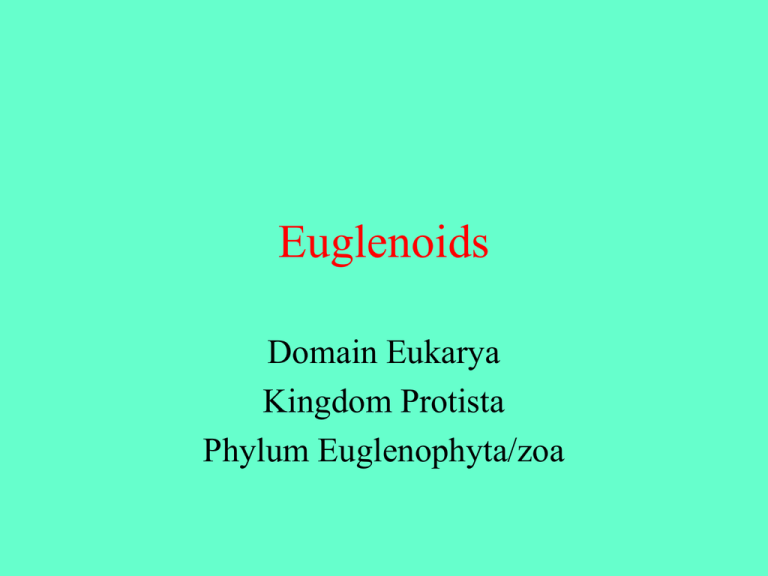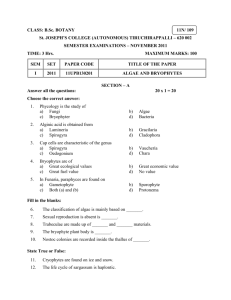The Organism as a Unit of Life
advertisement

Euglenoids Domain Eukarya Kingdom Protista Phylum Euglenophyta/zoa Looking Back at Bio 115 The Organism as a Unit of Life Cellular Structure (cell = unit of life)…one or many! Metabolism = Homeostasis (PSN, Resp, N2fix, ferment, etc.) Growth = irreversible change in size Reproduction…failure = extinction Acclimatization-short term responses = behavior Adaptation-long term responses = evolution Lumpers Shifting Kingdoms Plantae Protista Splitters 2 3 5 6 8 Bacteria Bacteria Bacteria Bacteria Bacteria Archaebacteria Archaebacteria Archaebacteria Archaebacteria Archaebacteria Archezoans Archezoans Archezoans Archezoans Archezoans Euglenoids Euglenoids Euglenoids Euglenoids Euglenoids Chrysophytes Chrysophytes Chrysophytes Chrysophytes Chrysophytes Green Algae Green Algae Green Algae Green Algae Green Algae Brown Algae Brown Algae Brown Algae Brown Algae Brown Algae Red algae Red algae Red algae Red algae Red algae Slime Molds Slime Molds Slime Molds Slime Molds Slime Molds True Fungi True Fungi True Fungi True Fungi True Fungi Bryophytes Bryophytes Bryophytes Bryophytes Bryophytes Tracheophytes Tracheophytes Tracheophytes Tracheophytes Tracheophytes Protozoans Protozoans Protozoans Protozoans Protozoans Myxozoans Myxozoans Myxozoans Myxozoans Myxozoans Multicellular Animals Multicellular Animals Multicellular Animals Multicellular Animals Multicellular Animals Extant How Many Kingdoms? 8 5 3 Extinct 2 1 Original Cell Euglenozoa • Flagellated protists which can be photosynthetic • Odd features Protein pellicle instead of cell wall Odd mitochondria (discoid cristae) Chromosomes condensed during interphase • 400 species (many more likely unknown parasites!) • Two sub-phyla: 1. 2. Kinetoplasta (Trypanosoma gambiense) sleeping sickness Euglenoida (Euglena) photosynthetic, chlorophyll a,b, paramylum http://cal.vet.upenn.edu/paraav/images/10-16.jpg Trypanosoma gambiense Blood-borne parasite Flagellated undulating cell Nucleus Flagellum Vectored by Tsetse fly between alternate hosts Chemical agent causes African sleeping sickness http://niah.naro.affrc.go.jp/disease/fact/image/trypanosoma.jpg Euglena gracilis Posterior extension Mitochondrion Pyrenoid Nucleus Paramylon grain http://bio.rutgers.edu/euglena/ Chloroplasts Protein pellicle (striations) Contractile vacuole Anterior invagination With internal short flagellum Long flagellum rooted here also http://www.ac-rennes.fr/pedagogie/svt/photo/microalg/euglena.jpg (not shown) Eyespot Extant How Many Kingdoms? Euglenoid mitochondria are unique! Chlorophyte algal endosymbiosis Extinct Original Cell For euglenoids, the chloroplast is a secondary Eubacterium endosymbiosis endosymbiosis. Though sketched here as single events, these endosymbioses were very likely multiple events! http://bio.rutgers.edu/euglena/ Cyanobacterium endosymbiosis Scarcodine and Actinopod Protozoans Domain Eukarya Kingdom Protista Phylum Sarcodina http://www.microscopy-uk.org.uk/mag/imagsmall/amoebafeeding3.jpg Amoeba proteus A freshwater amoeboid protist Engulfing a Staurastrum green alga Contractile vacuole Food vacuoles Nucleus The pseudopodia assist in locomotion and phagocytosis, but they also secrete proteolytic enzymes to digest particles outside the cell. http://oceanexplorer.noaa.gov/explorations/de epeast01/logs/sep24/media/Foram_600.jpg Pseudopodia Mitochondria Marine relatives, the foraminifera, secrete calcareous shells, contributing to reefs and sands. Arcella gibbosa Freshwater amoeboid protist Chitinous test Hyaline connections to the cell Food vacuoles obvious Some have two or more nuclei Pseudopodia protrude from the test Feeding here upon green algae http://www.microscopy-uk.org.uk/micropolitan/fresh/protozoa/arcella.jpg Orbulina universa, or Globigerina bulloides A living foraminiferan demonstrates its many and delicate pseudopodia In addition to capturing food items, the foram also receives nutrients from its endosymbionts http://plaza.ufl.edu/mrosenme/livingforam.jpg Actinosphaerium eichhorni This organism is an actinopod. Its axipods are stiff projections rather than delicate pseudopodia. The axipods are stiffened primarily by silicates taken from the water. http://home.t-online.de/home/ghstanjek/hmic6.jpg It is related to many radiolarians which are known only from their tests fossilized in silicate deposits. http://micro.magnet.fsu.edu/micro/gallery/radiolarians/largeradiohoff.jpg






